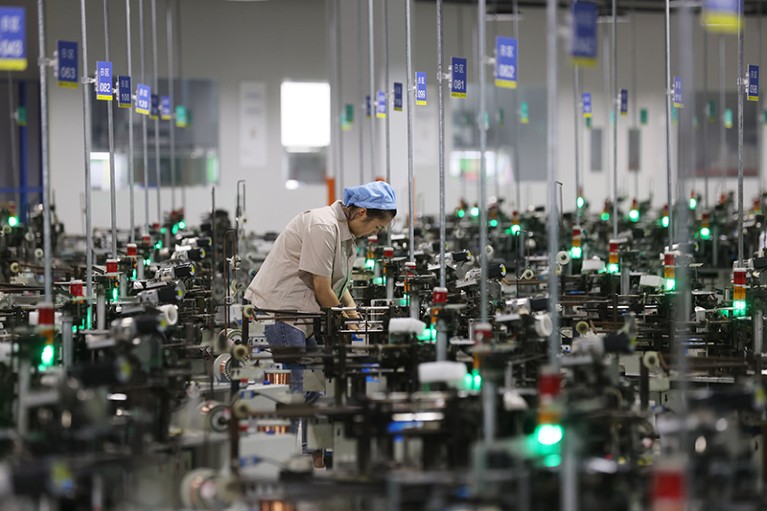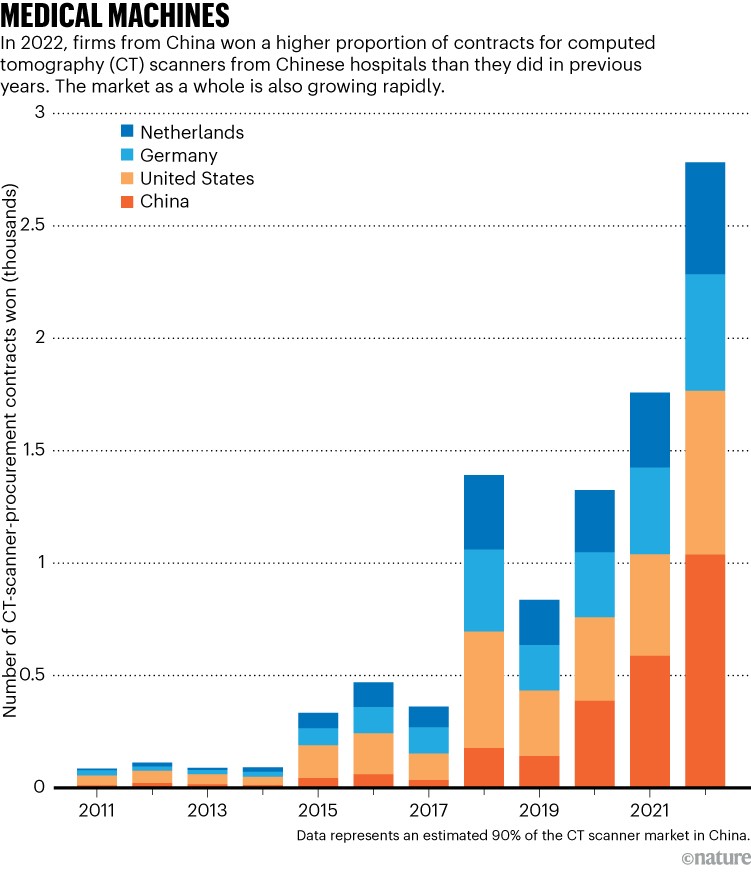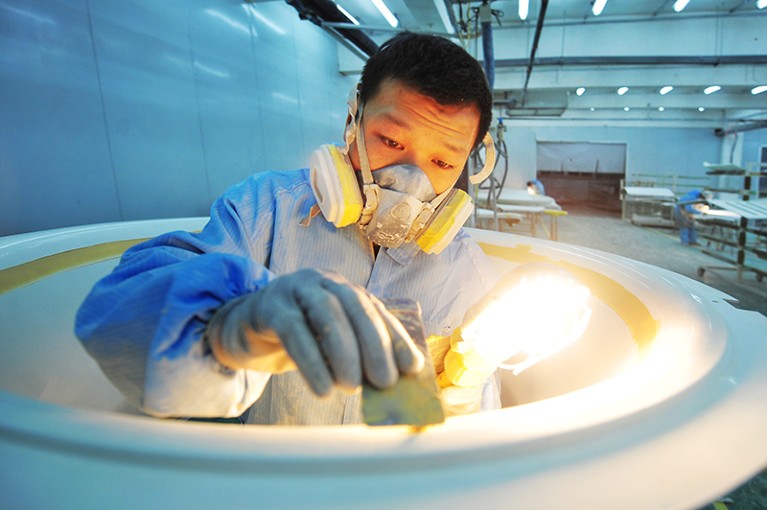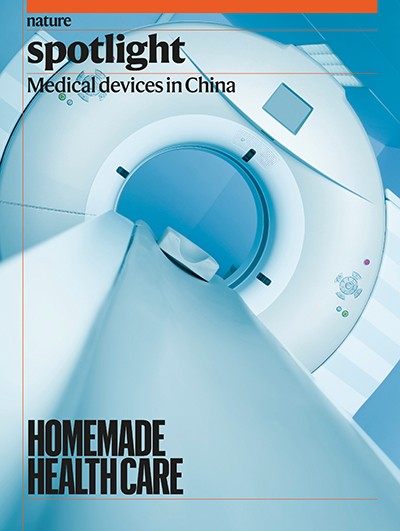[ad_1]

China wants to use and manufacture more of its own medical equipment.Credit: VCG via Getty Images
As a sinology student in the early 1990s at Nanjing University, Elisabeth Staudinger “got a flavour of what health care felt like for the people in China”. As part of her studies, she had to venture more than 2,000 kilometres to Yunnan in China’s southwest corner. Back then, parts of the province were so remote that people who needed medical attention would often have to wait for Mondays to roll around, when visiting merchants, physicians and dentists would set up shop in a weekly market.
“Fast forward to today, you have very reasonable hospitals and health-care infrastructures across the country” alongside near-universal health coverage, says Staudinger, who is now a managing board member of the global medical technology company Siemens Healthineers in Erlangen, Germany. “Things are massively better than it used to be,” she says. “But there’s still a lot of work to do.”
Nature Spotlight: Medical devices in China
China has a population of around 1.4 billion people, one-fifth of whom are over the age of 60. A burgeoning middle class and the accompanying rise in medical conditions linked to affluence, such as type 2 diabetes and hypertension, has meant that China has embraced preventive care, alongside treatment, says Jeroen Groenewegen-Lau, an analyst who studies science, technology and innovation at the Mercator Institute for China Studies (MERICS), a think tank in Berlin. But this has meant opening up the market to expensive treatments and technology, he says.
Aware of the costs, the Chinese government began a drive around a decade ago to produce and use more locally manufactured medical devices, says analyst Alexander Brown, also at MERICS. In particular, the focus has been on high-end equipment such as X-ray scanners, which can aid early disease detection. The push intensified further in 2021, in the hope of slashing costs and meeting the evolving health-care needs of an ageing population, while also boosting innovation and enhancing national security by curtailing imports.
The strategy is affecting both China’s medical-device sector and the medical-technology industry as a whole. Medical technology includes devices that use information technology to detect, collect and upload data. Hospitals in China have been instructed to procure products made in the country when possible, and domestic and foreign manufacturers have altered their business operations and focus. In 2021, the most recent year for which data were available, China held 20% of the medical-device market share, second only to the United States.
Gathering momentum
The Chinese government promotes its ‘make local, buy local’ strategy in a variety of ways: dedicated innovation parks, subsidies and research funding for domestic medical-technology companies, and centralized volume-based purchasing for public hospitals.
“But technically there is only one regulation on the books that is explicitly around Chinese-product procurement,” says Helen Chen, a managing partner based in Shanghai at the global firm L.E.K. Consulting. In May 2021, the Ministry of Industry and Information Technology, and the Ministry of Finance introduced Order 551, which comprises a list of 315 products. Around half of these are medical equipment such as ophthalmic lenses and medical lasers, while the rest includes items such as those used in marine, geological and geophysical work — ground-based radars, for example. State-owned firms looking to procure such items must ensure that the equipment is made of 25–100% of locally manufactured parts.
Unleashing the power of big data to guide precision medicine in China
Order 551 must be viewed in the broader context, says Chen, “which is that China, in general, is trying to be much more self-sufficient in its health-care products”. The directive came just a month after the Chinese government outlined a five-year plan aimed at propelling six or more Chinese companies into the world’s top 50 medical-device firms — up from the 4 that were in the top 100 in 2021. The country’s ambition for its medical-device sector can be traced back further, however. In 2010, medical devices were identified as one of 20 Strategic Emerging Industries — alongside biotechnology, renewable energy, and the Internet of Things — and the central government began dedicating five-year plans to the sector.
In 2014, Chinese President Xi Jinping highlighted the cause further, announcing: “It is necessary to accelerate the localization of high-end medical devices to decrease production costs and to promote the continuous development of national enterprises.” The pivot to producing products such as high-value imaging, diagnostic and treatment equipment — including computed tomography (CT) scanners, ultrasound and dialysis machines, as well as implantables such as pacemakers — is particularly notable because up until that point, medical manufacturing had centred mainly on producing syringes, gloves, gauzes and other low-end disposables (see ‘Medical machines’).

Source: Alexander Brown/Merics
But for industry watchers such as Chen, the real game-changer occurred in 2015, when the government announced its Made in China 2025 (MIC2025) initiative. The strategic plan boldly declared the country aimed to become a global manufacturing powerhouse for ten industries — including robotics, electric vehicles and medical devices — by 2025. China hopes to achieve this by boosting local industrial capabilities in research and development, design, and the procurement of crucial components, as well as by moving assembly processes into the country.
Among other targets, MIC2025 calls for 70% of mid-to-high-end medical devices to be produced domestically by 2025, and for this to rise to 95% by 2030.
With only a year to the first deadline, Brown says: “I think they still have a way to go. They haven’t been able to catch up as much as they would have liked in contrast to something like new-energy vehicles.”
“But it’s not for the lack of effort — China has been funnelling a lot of money into the sector. I think the hurdles are partly to do with the highly specialized nature of medical devices,” Brown adds. “Still, Made in China has had the greatest impact in terms of building up local industrial capacity.”
How paediatrician researchers are advancing child health
And it’s a tried-and-tested approach. The country has gained dominance in industries such as pharmaceuticals, solar panels and machine tools, according to a report by Brussels-based think tank, the European Centre for International Political Economy. Policymakers first identify sectors and technologies that they think are important to the country’s economic development and security. The government then initiates policies to grow domestic industries that can challenge global firms (see go.nature.com/49rlyhv).
China’s ambitions for its medical-device industry look no different. A profusion of policy and fiscal initiatives to boost local production and use of medical devices appeared after MIC2025. In April 2022, for instance, provincial governments in Anhui, Hubei and Shanxi told hospitals to limit their use of medical and testing equipment to those produced domestically.
The government also began offering incentives, such as reduced rent, to entice firms to move or set up offices in four medical-device industrial zones — the Bohai Economic Rim including Beijing; the Yangtze River Delta encompassing Shanghai; the Pearl River Delta, made up of Guangdong, Shenzhen and a handful of other cities; and Central China, which includes Wuhan, Chengdu and Chongqing. It also increased tax benefits for research and development investments: rising from 1.7 billion yuan (US$236 million) in 2017 to 11.4 billion yuan in 2022, according to a MERICS analysis of 122 medical-technology firms listed on the Shanghai, Shenzhen and Beijing stock exchanges (see go.nature.com/3urvdkn).
In July 2023, the Shenzhen Institute of Advanced Technology began mass producing a magnetic resonance imaging (MRI) instrument it had developed. And at the start of the COVID-19 pandemic, United Imaging Healthcare in Shanghai supplied more than 100 domestically produced CT scanners and X-ray machines to hospitals including those in Wuhan, Shanghai and Beijing.
In 2019, one of China’s biggest medical-technology firms, MicroPort in Shanghai, reported that surgeons had completed the first successful surgery, a prostatectomy, with its lacroscopic robot Toumai. The four-armed Toumai can do complex surgeries in narrow spaces in the body, such as urethral reconstructions. It can even be operated remotely.
Ripples far and wide
According to a 2021 analysis by consultancy firm Deloitte (see go.nature.com/3uyujzw), the market revenue of China’s medical-device industry more than doubled between 2015 and 2019, constantly outpacing the expansion in gross domestic product with an annual growth rate of roughly 20% since the launch of MIC2025.
Some sectors have even begun to turn the tide on trade — manufacturers of pacemakers, for instance, saw their global exports grow by 110% between 2015 and 2020. Meanwhile, sales of pacemakers by foreign competitors to China rose by 2%.
Overall, the market share of domestic brands producing high-end devices has risen from 20% to 30% in the past decade. US and European multinationals such as Siemens, GE HealthCare and Medtronic continue to dominate the sector, however, says Rohit Anand, an analyst at the consulting firm GlobalData in Hyderabad, India. This difference in market share boils down to “substantial disparity in product quality, scale and efficiency”, he says.

Parts of high-end devices such as computed tomography scanners are now made in China.Credit: Feature China/Future Publishing via Getty
Brown observes that medical devices are niche products that require specialized knowledge, and Chinese firms have struggled to gain a foothold.
Citing medical robotics as an example, he adds: “There isn’t a big market in China because they are very expensive. The average Chinese customer just can’t afford to pay for that, and the ones that can afford to would probably opt for a leading American firm over some inexperienced Chinese one.”
Attitudes among medical professionals are changing, however. A 2020 survey of Chinese hospital workers, conducted by the firm L.E.K. Consulting, found that 3% “use Chinese materials when possible”. In a follow-up survey a year later, after Order 551, around 30% said they always use Chinese materials (see go.nature.com/3iba26v).
Often, the decision comes down to practicalities, says Deloitte analyst Alan MacCharles in Shanghai. “You might have two or three options and the doctor might say: ‘The Western device is slightly better but because I haven’t had training on that system in awhile, I’m much more proficient with the Chinese brands.’”
Because of new purchasing regulations, many international manufacturers have opted to establish local operations in China. Some partner with local firms, setting up joint ventures, such as the ones between Sinopharm Imaging in Beijing and US firm GE Healthcare, or between Shanghai Electric and Siemens.
From tea to tofu: why Chinese dietary staples are rich pickings for research
A handful of prominent foreign firms have established their own manufacturing plants in the country. Sysmex in Kobe, Japan, now assembles its blood and urine testing equipment in Shandong. Similarly, Dutch firm Philips produces a handful of high-end scanners in China, such as its EPIQ Elite ultrasound series, which includes an AI-powered cardiovascular machine. In 2020, Philips launched its Ingenia Ambition MRI, which is made in China and boasts a 50% reduction in scan times. It is the first MRI to operate without helium gas, a non-renewable resource that is in scarce supply.
And at an international trade fair last May, GE Healthcare displayed 23 medical devices, 18 of which were made and developed in China. One highlight was the ultra-high-end Revolution CT scanner, which boasts the ability to conduct a coronary examination “in one heartbeat under any heart rate and rhythm conditions”, according to GE Healthcare. The firm began manufacturing the scanner at its Beijing factory in 2020. Of the CT equipment that the company ships to customers worldwide, 70% are made at that factory.
Making the decision to start manufacturing in China isn’t taken lightly. “It’s not an easy process because the cost of building these plants for high-end devices is high,” says MacCharles. “You can have local supply-chain and intellectual-property issues, it takes years to get fully certified and basically you can’t produce anything for quite some time.”
US firms, in particular, face challenges, given the ongoing tensions between the two nations, says Grace Fu Palma, founder of China Med Device in Beijing, a consultancy that offers regulatory and business advice to foreign firms looking to enter the Chinese market. “The political situation is definitely having a negative impact on the entry of foreign firms.”
Staudinger says that China continues to be a priority location for Siemens, which has been operating there for more than 30 years and has six research and development sites in the country, despite increasing pressures for consumers to buy from local firms. “The regulations are sometimes projected as this thing where they want to get foreign companies out of the country,” she says. “But that is not what we have experienced.”
“As long as you’re part of the journey and a part of supporting the direction of building a robust, high-quality health-care system in China,” says Staudinger, “you’ll feel very welcome.”
[ad_2]
Source Article Link





